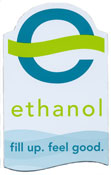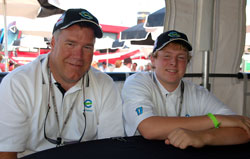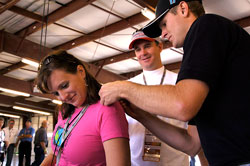 The 2007 Indy Car Series will go down in the racing history books as the first year a major motorsport embraced a renewable and environmentally-responsible fuel source, setting the standard
The 2007 Indy Car Series will go down in the racing history books as the first year a major motorsport embraced a renewable and environmentally-responsible fuel source, setting the standard
for the “Greening of Racing”.
This edition features comments from interviews done at the last Indy Car Series race event for this season, the PEAK Antifreeze Indy 300 at Chicagoland Speedway.
The “Fill up, Feel Good” podcast is available to download by subscription (see our sidebar link) or you can listen to it by clicking here (5:30 MP3 File): [audio:http://www.podtrac.com/pts/redirect.mp3?http://www.zimmcomm.biz/epic/epic-podcast-9-10-07.mp3]
The Fill Up, Feel Good theme music is “Tribute to Joe Satriani” by Alan Renkl, thanks to the Podsafe Music Network.
“Fill up, Feel Good” is sponsored by the Ethanol Promotion and Information Council.


 Just one word is fitting for Canadian Club Driver Dario Franchitti: Champion. Dario cinched the the 2007 Peak Antifreeze Indy 300 after Scott Dixon fell behind the Scottish driver in the last few hundred feet of the race after racing with Dario neck and neck. The win also secured Dario the 2007 IndyCar Series Title. The Andretti Green Racing teammate also won the Indy 500, the Iowa Indy 250 and the Richmond Indy Challenge, where he set both a track record and an IRL record. Rumor has it Dario will be switching to stock cars next season. A report on
Just one word is fitting for Canadian Club Driver Dario Franchitti: Champion. Dario cinched the the 2007 Peak Antifreeze Indy 300 after Scott Dixon fell behind the Scottish driver in the last few hundred feet of the race after racing with Dario neck and neck. The win also secured Dario the 2007 IndyCar Series Title. The Andretti Green Racing teammate also won the Indy 500, the Iowa Indy 250 and the Richmond Indy Challenge, where he set both a track record and an IRL record. Rumor has it Dario will be switching to stock cars next season. A report on  Motorsports and ethanol are a good fit for Ethanol Promotion and Information Council member Rob Herbon. Rob is the sales director for Fremont Industries in Shakopee, MN. I spoke with him about ethanol’s role in motorsports, what that role has done for the consumer market and what that role has done for his company.
Motorsports and ethanol are a good fit for Ethanol Promotion and Information Council member Rob Herbon. Rob is the sales director for Fremont Industries in Shakopee, MN. I spoke with him about ethanol’s role in motorsports, what that role has done for the consumer market and what that role has done for his company. I managed to grab some shots of Ryan Hunter-Reay as he was gearing up just before the race. Earlier, I grabbed an interview with the Team Ethanol Driver getting some final thoughts before the 2007 season closer.
I managed to grab some shots of Ryan Hunter-Reay as he was gearing up just before the race. Earlier, I grabbed an interview with the Team Ethanol Driver getting some final thoughts before the 2007 season closer. The 2007 Peak Antifreeze Indy 300 race is underway! I’ll be bringing updates of the season finale race here at the Chicagoland race track throughout the day.
The 2007 Peak Antifreeze Indy 300 race is underway! I’ll be bringing updates of the season finale race here at the Chicagoland race track throughout the day. The 2007 Peak Antifreeze Indy 300 marks the first time the President of Eclipse Inc. has gotten to peer into the cockpit of an IndyCar and meet Team Ethanol Driver Ryan Hunter-Reay. In fact, it’s the first time Lachlan Perks has been to an EPIC sponsored racing event. Lachlan and I chatted about his experience and about ethanol.
The 2007 Peak Antifreeze Indy 300 marks the first time the President of Eclipse Inc. has gotten to peer into the cockpit of an IndyCar and meet Team Ethanol Driver Ryan Hunter-Reay. In fact, it’s the first time Lachlan Perks has been to an EPIC sponsored racing event. Lachlan and I chatted about his experience and about ethanol. What could be a better souvenir for the EPIC 2007 Peak Antifreeze Indy 300 experience than an autograph from Team Ethanol Driver Ryan Hunter-Reay? Well, perhaps a picture and a souvenir would be better. Well, members of the
What could be a better souvenir for the EPIC 2007 Peak Antifreeze Indy 300 experience than an autograph from Team Ethanol Driver Ryan Hunter-Reay? Well, perhaps a picture and a souvenir would be better. Well, members of the  Members of the
Members of the  It has already been a busy day here at the Chicagoland race track in Joliet, IL. The Ethanol Promotion and Information Council has a lot going on for its members and for its Race to Go Green Sweepstakes Jerry and Bud Carter winners at the final IndyCar Series Race for the 2007 season.
It has already been a busy day here at the Chicagoland race track in Joliet, IL. The Ethanol Promotion and Information Council has a lot going on for its members and for its Race to Go Green Sweepstakes Jerry and Bud Carter winners at the final IndyCar Series Race for the 2007 season.  I’ll be posting coverage on the garage tour and the autograph session with with Ryan Hunter-Reay, along with interviews from several EPIC members, EPIC Executive Director Tom Slunecka, Team Ethanol Driver Ryan Hunter-Reay and Rahal-Letterman Racing’s very own Bobby Rahal. But first, I need to run down to the track and grab some shots of Jerry and Bud during their “Hot Lap,” a trip around the track in an official pace car as part of the VIP treatment these two are receiving as sweepstakes winners. I’ll catch you up to speed with everything EPIC has going on when I get back.
I’ll be posting coverage on the garage tour and the autograph session with with Ryan Hunter-Reay, along with interviews from several EPIC members, EPIC Executive Director Tom Slunecka, Team Ethanol Driver Ryan Hunter-Reay and Rahal-Letterman Racing’s very own Bobby Rahal. But first, I need to run down to the track and grab some shots of Jerry and Bud during their “Hot Lap,” a trip around the track in an official pace car as part of the VIP treatment these two are receiving as sweepstakes winners. I’ll catch you up to speed with everything EPIC has going on when I get back.